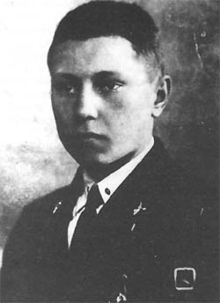Alexander Pokryshkin
[3] He grew up in a poor, crime-ridden part of town, but unlike most of his peers he was more interested in learning than in fighting and petty crime.
During that time his creative nature became clearly visible: he invented improvements to the ShKAS machine gun and the R-5 reconnaissance aircraft among other things.
Finally, during his vacation in the winter of 1938, Pokryshkin was able to circumvent the authorities by passing a yearly civilian pilot program in only 17 days.
On 3 July, having claimed several more victories, he was shot down by German flak behind enemy lines and spent four days getting back to his unit.
During the first weeks of the war, Pokryshkin began to see very clearly how outdated the Soviet combat doctrine was, and started slowly drafting his own ideas in his meticulous notebooks.
He fought in very complicated conditions: constant retreat, poor- to no-controlling and communication from HQ, and overwhelming odds versus a superior opponent.
One of the German bombers saw Pokryshkin firing the only machine gun in the area and flew straight at him, dropping small bombs in a shallow dive.
In the autumn of 1941 Pokryshkin, flying a MiG-3 (possibly winter-camouflaged), took off in sleet and rain conditions after two other pilots had crashed on takeoff.
His mission was to locate von Kleist's 1st Panzer Group, which had been stopped in front of Shakhty, and then their position lost by the Soviet forces.
In that period Pokryshkin flew missions escorting Su-2 and Il-2 Shturmovik aircraft, and frequently was engaged by German fighters.
Initially Pokryshkin dived to escape, but realizing that the heavier and faster Gustavs would catch him, he performed a chandelle and then a barrel roll.
But once more Pokryshkin performed a barrel roll, forced Dammers to slide forward, and then shot down the German ace.
Pokryshkin's most significant contribution to the war effort and the most impressive kill record came during the battle for the Kuban region in 1943.
Pokryshkin's innovative tactics of using different fighter types stacked in altitude, the so-called 'pendulum' flight pattern for patrolling the airspace, and the use of ground-based radar, forward based controllers, and an advanced central ground control system, contributed to the first great Soviet Air Force victory over the Luftwaffe.
[citation needed] In early January 1943, 16th Guards Fighter Aviation Regiment was sent to 25th Depot Fighter Aviation Regiment, a unit tasked with checking that Soviet-made and Lend-Lease aircraft were ready for combat service near the Iranian border, to re-equip with new aircraft, and also to receive new pilots.
[11][12] In most subsequent fights, Pokryshkin would usually take the most difficult role, attacking the German flight leader, who was often an aggressive experte.
On 6 May 1943 Pokryshkin shot down a Bf 109, probably the plane of 9-kills ace Unteroffizier Heinz Scholze (4./JG 52), who crashed while trying to land at Kuteinikovo.
He flew aircraft designated 100 for the rest of the war, such as P-39N-5 42-19185, after 42-9004 was damaged in August or September 1943, except for the test of the Berlin autobahn as a runway in Konstantin Sukhov's "White 50", which was much photographed.
From 10 PM that night at least through the following day, Pokryshkin, 298th Fighter Aviation Regiment's Major Taranyenko, and the 16th Guards' Commissar, Gubarevim, and some "Osobists" (NKVD people) completed interrogations and investigations.
Gubarevim, with difficulty, was able to clear Pokryshkin's name and reputation, and "Sasha" was thereupon awarded his second Hero of the Soviet Union on 24 August 1943.
Pokryshkin shot down three Junkers Ju 88s in a single pass, overcome by hatred, as he had just found out that the entire family of Zhmud, his mechanic, had been killed in German-occupied territories.
On 19 August 1944, for 550 front-line sorties and 53 official kills, Pokryshkin was awarded the Gold Star of the Hero of the Soviet Union for the third time.
Pokryshkin was forbidden to fly altogether, but managed to circumvent the rule a few times and still continued to score an occasional kill.
The whole 16th Guards Fighter Aviation Regiment engaged a large formation of Ju 87s heading towards the Soviet ground forces escorted by Fw 190s and Bf 109s.
Soviet pilots liked this aircraft, and found it quite competitive with the Messerschmitt Bf 109 and superior to the Focke-Wulf Fw 190 at the low air combat altitudes common on the Eastern Front.
Pokryshkin subsequently cancelled his regiment's conversion, and there are multiple reports that they instead began flying the Bell P-63 Kingcobra.
(This is according to the document for an award to an aircraft mechanic assigned to 42-19158, for keeping it airworthy and ready to fly combat missions for 100 flights in a row.)
In the famous photo taken of him using a stretch of German "autobahn" as a runway, he was flying a P-39Q-15 designated "White-50", with the serial number painted out (the same aircraft was originally assigned to K. V. Sukhov).
[19] However, Levchenko's claims are generally disputed in 21st century estimates, which tend to place Pokryshkin's tally in the mid 40s.
[20] Russian historian Mikhail Bykov credited him with 43 individual and 3 shared victories in a 2014 book;[11] a decade earlier, in an article titled Мутное Небо 1941 года ("The Murky Sky of 1941") with Aleksandr Rodionov he claimed that Pokryshkin tried to steal Rechkalov's kills during 1941.




